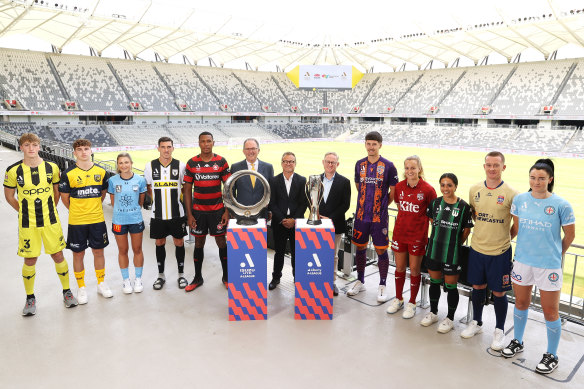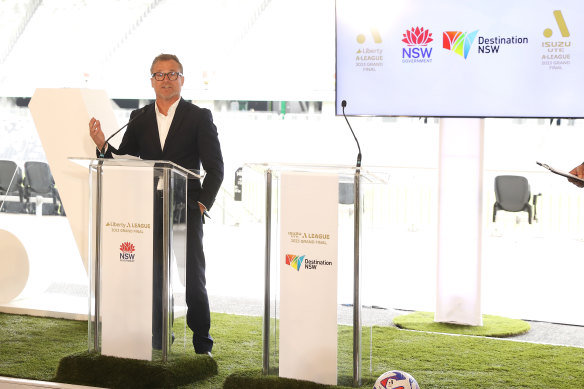This was published 2 years ago
Opinion
If there was a World Cup for self-sabotage, Australian soccer would be champions
Vince Rugari
ReporterThe day after the Socceroos were knocked out of the World Cup, left-back Aziz Behich said the players had done their part, and that it was over to the sport’s administrators to capitalise on the incredible momentum created by their accomplishments in Qatar.
“This should be a massive stepping stone for football in Australia to go forward. I can’t see why it shouldn’t,” said Behich, one of 20 current or former A-League products in Graham Arnold’s squad.
“It should be a no-brainer, really.”

The next three A-League grand finals for men and women will be held in Sydney - if the competition survives that long.Credit: Getty
Well, here we are, 10 days on from the Socceroos’ last dance in Doha, and pretty much every stakeholder in the sport is sitting back, totally aghast at how it could have possibly come to this.
By selling the next three men’s and women’s A-League grand finals to Sydney, and completely misreading how this decision would go down with the sport’s highly parochial fan base, the Australian Professional Leagues – the organisation which has run the A-League, to varying degrees of success, since its legal independence from Football Australia two years ago – have outdone themselves.
With their abysmal handling of an ill-advised decision, the APL has allowed a spot fire to become a raging inferno that threatens to consume them all, and everything they’ve built.
If they had put greater emphasis on how badly the 12 A-League clubs needed the money, and more carefully managed this announcement, they might have found a way to convince fans to begrudgingly accept this unpalatable move as a necessary evil.

Danny Townsend, the APL chief executive, was grilled at Monday’s press conference.Credit: Getty
According to sources with knowledge of the situation, the three-year deal with the NSW government is worth just under $12 million in cash – a drop in the ocean compared to the huge sums the clubs have blown since COVID-19, but welcome relief that will help struggling clubs keep the lights on. They can’t use the $140 million in private equity money provided by Silver Lake to cover their losses, as it’s there to spend on growth strategies.
APL chief executive Danny Townsend tied himself in knots on Monday when the announcement was made, and again on Tuesday, when he did the media rounds. He said this was all about building a tradition, but provided little detail as to how they’d do that – without acknowledging they were also dismantling a long-standing tradition, stretching back to the days of the old National Soccer League (which he played in), where the highest-ranked team earns the right to host the grand final.
And he told the fans who treasured this tradition that their reactions were emotional and that one day they’d thank the APL for their foresight.
Not likely. Gaze upon Twitter – which is, for better or worse, the default dashboard for anyone involved in Australian soccer – and you’ll see an endless stream of rusted-on supporters returning their memberships, cancelling their Paramount+ subscriptions and refusing to engage at any level with the A-League until the decision is reversed. Network 10 is furious.
Supporters are planning to protest this weekend, with Melbourne Victory and Melbourne City’s main active fan groups to walk out of AAMI Park at the 20-minute mark of Saturday night’s derby – scenes last seen during the great FFA v fans war of 2015. The A-League still hasn’t fully recovered from that sorry episode, and now APL insiders fear this one has not only reopened old wounds, but fatally infected them. For the hardcore fans, who have stuck around after all the little controversies and embarrassments over the years, this is the final straw.
Many players are furious, too. Craig Goodwin, spoke generally about the importance of grand finals in a video used to promote the APL’s deal with Destination NSW, which left fans to assume that he supported it. He didn’t - in fact, sources say he refused to speak to it directly - and made his position clear on social media, as have some of his angry colleagues.
Then Townsend said this new tradition might actually become a tradition somewhere other than Sydney if other states were willing to pay more at the end of this three-year contract. That infuriated the NSW government. (Townsend also said no other state could match their offer. Visit Victoria said they were “never approached”.)
Then he said that all the clubs were on the same page and saw the bigger picture. But then other owners, including Perth Glory’s Tony Sage and Brisbane Roar’s Chris Fong, came out and claimed they weren’t properly consulted, or didn’t agree with it.
Townsend insisted it was a unanimous vote by the APL’s board, which is made up of seven people, including five club representatives, one from Silver Lake and one FA appointment – and as far as this masthead can tell, the club reps all voted in favour. But then Melbourne Victory’s Anthony Di Pietro, perhaps frightened by the white-hot anger of the Victory fan base, stepped down from the APL board, saying he wasn’t free to advocate for the best interests of his club and the sport in his state.
Then the owners, all 12 of them this time, met on Tuesday to discuss the matter. Eight clubs supported the decision, and only four – Victory, Adelaide, Western United and Perth Glory – were against it, so the APL doubled down publicly. More fuel for the fire. They’ll meet again on Thursday, and the fire brigade should be on standby.
All of this puts an overdue spotlight on the APL’s governance structures, which are clearly not fit for purpose. Either the APL should give each club an equal vote – not five out of 12, leaving seven powerless – or the board should be completely independent.
That was, indeed, the recommendation of the Crawford Report in 2003, but was not adopted by Frank Lowy when he took charge of the game. The A-League clubs also once committed to an independent board after splitting from FFA, but we’re still waiting – as we are for the annual governance reviews prescribed by the New Leagues Working Group.
But it doesn’t really matter in the end who voted for what, or who’s saying one thing behind closed doors and another to the fans, or what some report said from however many years ago. All that matters now is that a competition that should be basking in a post-World Cup afterglow is instead engulfed in anarchy.
As the last month has shown, there are scores of Australians who genuinely love soccer – some who are new to the game, some of whom have followed the A-League through the ups and downs, and others who jumped off but might be open to giving it another go.
They now see a bunch of blokes in suits arguing with each other, who failed to read the room, and who have burned through what little faith the soccer public had left in their ability to turn the A-League into a success again. It may not survive their hubris.
Watch every match of the UEFA Champions League, UEFA Europa League and UEFA Europa Conference League on Stan Sport. Returns for the Round of 16 in February 2023, with all matches streaming ad-free, live and on demand.